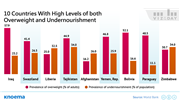
On average, nations with higher rates of undernourishment also have lower prevalences of people who are overweight or obese. But, this intuitive correlation exists only on the average. Real-world data shows large deviations across countries from this trend. Many developing countries with relatively high levels of undernourishment also have high rates of overweight and obesity at the same time. For example:In the Comoro Islands, 65 percent of the population is undernourished, making it one of the most undernourished nations in the world. The country simultaneously has elevated obesity rates: 49 percent of females aged 20 and older and 26 percent of males in the same age range.In Iraq, 26 percent of the population is undernourished while 62 percent of adult males and 68 percent of adult females are classified as overweight or obese.Poverty and hunger are by no means uncommon in Moldova, one of the poorest Former Soviet Union countries. And, yet, 59 percent of females and 45 percent of males are overweight or obese. What factors lead populations to develop such striking contrasts in the nutritional welfare of their citizens? Contributing factors include the following: Income inequality. Large income inequality between populations in the developing world contributes to this phenomenon. Segregation can reach very high levels even between adjacent income groups, so while lower-middle and middle-income classes rapidly increase food consumption, people in the lowest income brackets starve. Industrialization of the food supply. A second less obvious factor is also in play: increased urbanization, westernization, and a shift to cheaper industrially-processed foods have undercut the effectiveness of famine-averting initiatives. Striving to bring a rapid end to hunger, governments, and international organizations flood markets with cheap, highly processed and energy-dense food, such as white rice, flour, canned foods, processed meats, and sugar-rich soft drinks. Social and cultural shifts. Special aspects in the growth of obesity among middle-aged and older women associated with changing lifestyles, cultural differences and the quality of the maternal healthcare have also played a role in this tension between obesity and malnutrition in some populations. In the developed world, the prevalence of overweight and obesity in adult males is significantly higher than in females. In contrast, in developing countries, especially in Africa, the trend is reversed and rates of obesity among females are much higher than among males. You can observe this phenomenon in the map below. Source note: Data on the prevalence of overweight and obesity worldwide was obtained from the Institute for Health Metrics and Evaluation. The prevalence of overweight and obesity in adults aged 18 years and over is categorized as a body mass index (BMI) ≥25 kg/m² (BMI ≥30 =obese); in children, the classification is based on the International Obesity Task Force (IOTF) definition. Comparable estimates based on systematically identified surveys, reports, and published studies that include data for height and weight, both through physical measurements and self-reports, use mixed effects linear regression to correct for bias in self-reports.